Text

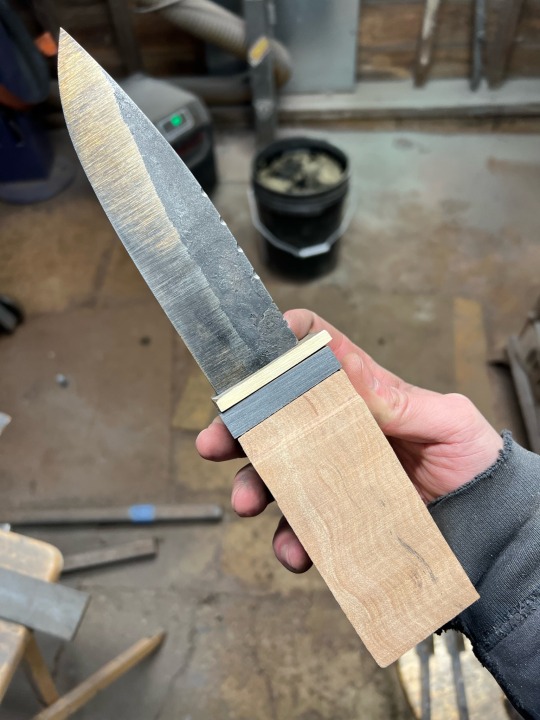


Some wip on todays fit up on this bushcraft hidden tang blade. Here’s the others I have in the works too! Keep an eye out for these when they’re done! Thanks everyone!!
21 notes
·
View notes
Text
Knives for Commoners
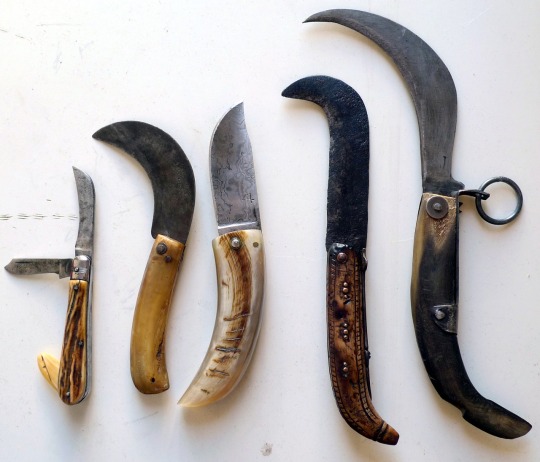
Precious daggers are cool and all, but I’m very fond of simple pocket knives, made to get shit done. So here are a few farmer / peasant knives, ranging from penknife- to sickle-sized.
1. Grafting knife (greffoir) from Thiers, France

This little multi-tool has a curved blade (very used and sharpened, it was originally wider) and a smaller wavy blade. It’s primarily for cutting the stock plant and the plant shoot (or bud) that you mean to graft, though it’s also good for small pruning jobs and general utility. It locks by slipjoint, the standard pocket knife locking mechanism that you’ll find in Swiss army knives. The small flat thing is a bark lifter, it’s made of bone and it’s used for bud grafting: when you insert a bud beneath the bark of a stem, you have to be extra careful to not injure the bark, so you don’t want sharp edges there.
The handle has scales of bone, carved like this in order to look like stag (which is rarer and more expensive). A similar way to accomplish this is “jigged bone” scales, found in a lot of old/classic American and English knives:
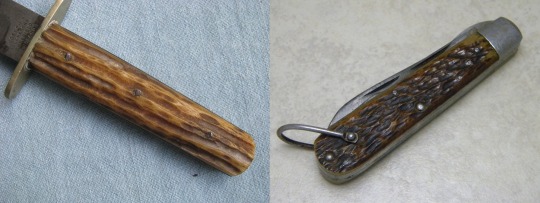
Sheffield hunting knife by Joseph Allen / American folding knife by Camillus
which I honestly think is too… regular, sometimes it looks machine-made even when it’s handmade. But this handle here is sculpted, it’s a work of art, I love it.
Manufactured sometime in *waves vaguely* the 20th century (probably 1930s-1960s) by the cutlery A. Bardin-Dozolmé. The blade is stamped “57 BARDIN Garanti”, which tells us nothing useful, this stamp’s been around since the 18th century. It’s 9.2 cm closed and 14.7 cm open. (3.62 / 5.79 inches)
2. Pruning knife (trinxet) from Mallorca, Spain
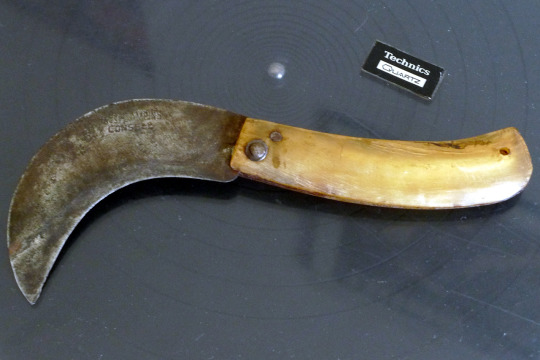
I’ve shown you this before, it’s got a curved carbon steel blade, a horn handle, and “friction lock” as they call it nowadays i.e. no lock whatsoever, it’s a clasp knife. And it’s the simplest, most convenient tool, I adore it.
Made by the cutlery Hermanos Campins in Consell, Mallorca, stamped “HNOS CAMPINS / CONSELL”, mid-20th century, 9.7 cm closed and 17 cm open. (3.82 / 6.7 inches)
3. Shepherd knife (couteau de berger) from Corsica, France
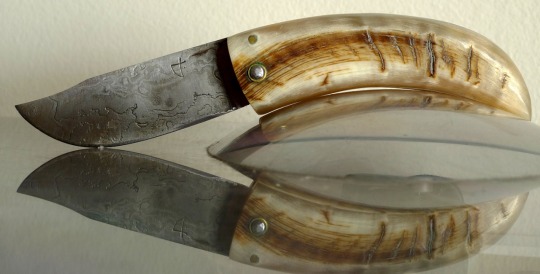
Another clasp knife (doesn’t lock), different shape, with a ram horn handle. Shepherd knives look like utility or bushcraft knives, their blades are not usually curved but they often have a clip-point shape, and they’re quite sturdy.
This is an outlier, it wasn’t really made for work, it’s for tourists or collectors. However, it’s handmade in the tradition of Corsican knife-making (as opposed to the more famous vendetta knives which were manufactured in mainland France, though I should clarify this shape isn’t uniquely Corsican either, it was widespread in both France and Italy), with a couple of modern touches: the blade is forged with a decorative flair, and the horn is first carved at the ridges (to emphasise it’s ram, I’m guessing) and then polished like a mirror.
It’s a strong, solid knife, and absolutely gorgeous.
Made by a local knife-maker (unfortunately I don’t know the name, the blade is signed but with a symbol) in Sartène, Corsica, maybe a decade ago. 11.5 cm closed and 19 cm open. (4.53 / 7.48 inches)
4. Folding billhook (roncola) from Italy


Billhooks are farming tools for cutting and pruning, though usually they have fixed blades. This one isn’t just folding, it’s an actual picklock, like a switchblade. (I mean with the same locking mechanism, it doesn’t open automatically or anything). The blade is carbon steel (that’s a lot of carbon, folks!) and the handle is beautiful, made of carved wood, with brass (I think) insets, and with a fancy external backspring.
Folding billhooks were exported from Italy to the UK. From 1961, a lot of them were imported by Whitby Knives, stamped “Whitby”, and were made in Maniago by Mauro Mario, a prolific knife-maker who also made a ton of switchblades. They looked like this:

The one I got looks earlier to me, but honestly I have no idea when it’s from. Early 20th? Late 19th? *uncertain noises* In any case, it’s 12 cm closed and 22.5 cm open. (4.72 / 8.86 inches)
5. Huge pruning knife (saca tripas) from Guanajuato, Mexico

And last but not least, a big fuck-off pruning knife, which locks securely with a ratchet and unlocks with a pull-ring. This is basically a folding sickle, you reap stuff with it, and can cut thick branches. The very curved carbon blade (it’s not over-sharpened, that’s its original shape) is stamped with a “J”, and the handle is made of horn, with an iron backspring.
The name is extravagantly bloodthirsty, it means “disemboweller” (saca tripas = “pulls out intestines”), and is of course a misnomer: this isn’t a weapon, it’s a farming tool. (Could it be used as a weapon? Well of course, but so can kitchen knives.) I’m not entirely sure if it’s really called that way, or only as a jest, or for the express purpose of selling one of them to bloodthirsty types, i.e. to morons. [Pet peeve: mislabeling work knives as “military” or “fighting” or “tactical”, when they’re clearly for utility, and often for some specific farming job. I even saw an ad for a knife like this describing it as a torture implement, for fuck’s sake people, IT’S FOR CUTTING PLANTS.]
So anyway, these knives can be found all over Mexico, and this one hails from the city of Guanajuato, or at least it was bought there at some point. It’s 16 cm closed and 28.5 cm open. (6.3 / 11.22 inches)
The lot of them
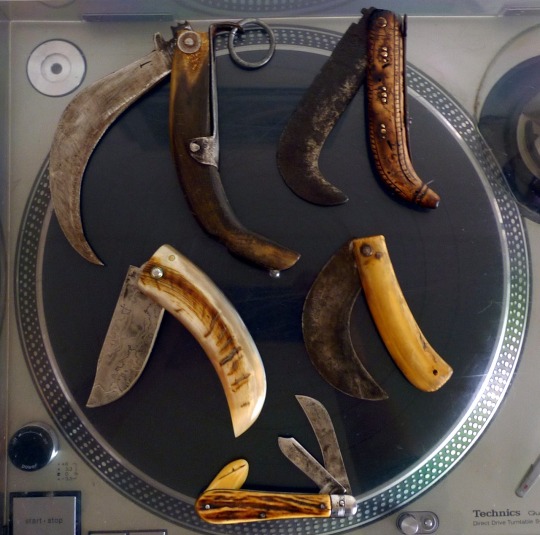
Despite the fact that all these are work knives (except the Corsican, but only technically: it emulates a specific, older work knife, and it’s still 100% functional), a clear effort has been made to make them pretty. And I LOVE this. Even the trinxet, which has a monochrome handle and no frills at all, is elegant in its simplicity, and they all have something going on, carvings, decorations, handles shaped to please the eye, materials chosen for their nice colour.
Aesthetically speaking, I think knives went to shit when plastic was adopted. (Practically speaking, I admit plastic is a lot more resistant to the elements; a handle of horn or bone must be kept dry or it shrivels, wood must be kept from dryness or it shrinks, bugs and mites eat it, it’s a mess.)
Not one blade here is stainless steel, and it shows.
Only the handle of the grafting knife (the smallest one) has scales riveted on a metal frame. Not coincidentally, it’s the most industrial production, it came out of a Thiers factory. (Thiers is a major cutlery centre, like Sheffield and Solingen.) The rest were hand-made in a workshop or at most a cottage industry (a bunch of people in a village construct parts and someone assembles them), and their handles are solid blocks of material (horn or wood), with a slit in the middle to fit the folded blade. That’s the simpler, older construction.
Folding knives are cool.
@tuulikki. And @victoriansword, @petermorwood, @peashooter85, I know you’re into the fancy stuff, but here I am plying humbler wares and hoping. :)
506 notes
·
View notes
Text
0 notes
Text
Knives of ill repute #3: Eustache
[Part of the series Knives of Ill Repute.]
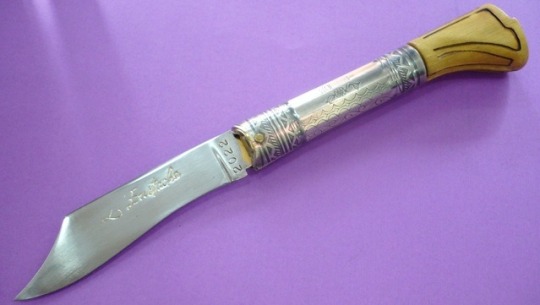
modern reproduction
The eustache is an old French knife, going back to the 18th century, though the name comes from Eustache Dubois, a 19th century knife-maker from Saint-Étienne. Originally it was a bog-standard peasant knife, no lock, no frills, just for work. It’s rarely made these days, however the design has survived into two iconic French pocket knives: the douk-douk got the blade (wavy, doubles as a grafting knife, very useful to farmers and gardeners), and the Opinel got a sturdier version of the handle.

But enough about the history of cutlery, what about crime? Enter Les Apaches. So by the late 19th-early 20th century, Paris experiences yet another wave of teenage rebels/fashion victims/criminals, except these ones somehow manage to stay completely apolitical. They just make trouble for trouble’s sake. They’re a constant nuisance, and they carry knives called eustaches to show off and occasionally stab people.

Les Apaches: always down to fuck (Le Petit Journal, August 1904)
However, by then “eustache” meant pocket knife in general, not any specific type. And the association may simply be owed to the fact that Apache (pronounced “ah-PASH”) rhymes with eustache. Hence their Chant (which I should stress was not written by them but for them, or rather against them, it’s satirical):
Ohé! les Apaches!
A nous les eustaches,
Les lingues à viroles,
Les longs d’assassins,
Pour le bidon des roussins
Et pour le ventre des cass’roles!
Which means, more or less: “Yay Apaches! With us the knives, the ringlock blades, the assassin’s garrotes, for the cops’ guts and the snitches’ bellies!” So it’s not super clear what these knives actually looked like. Some depictions and the mentions of rings remind us of navajas, and indeed similar knives were by then extremely popular and common in France (complete with pull-ring, external backspring, and noisy ratchet), and had many names besides eustache: cra-cra, à palme, à cran d’arrêt, catalan, and a few years later, de poilu*.

* “Poilu” is slang for the French soldier in WWI. These knives weren’t an official army issue but they were mass-produced in staggering amounts. Basically, the trenches made bayonets impractical in 1914 and trench knives weren’t manufactured until 1916. In the meantime, cutlers in Thiers were told to increase the manufacture of the folding knives they were already making, and everyone rushed to get one. So if you’re French, it’s a safe bet that your (great-)grandpa had one. Probably your grandma too.
[Part of the series Knives of Ill Repute.]
140 notes
·
View notes
Text
NEW ❗
🥷 Japanese wisdom: Even if you need a sword once in a lifetime, you should always wear it.
✅ Knife Yenisei, steel D2 (Germany), Karelian birch, brass.
Slopes straight from 3.5 mm butt, blade length 110mm.
It is very comfortable in the hand, allows you to give a good load for cutting and gives you control of the entire length of the blade in your work 👍
💼 Includes a knife and a sheath made of genuine leather.
#handforgedknife #handmadeknife #etsygifts #huntingknives #carelianbirch #forgedknife #fixedblade
instagram
0 notes
Text



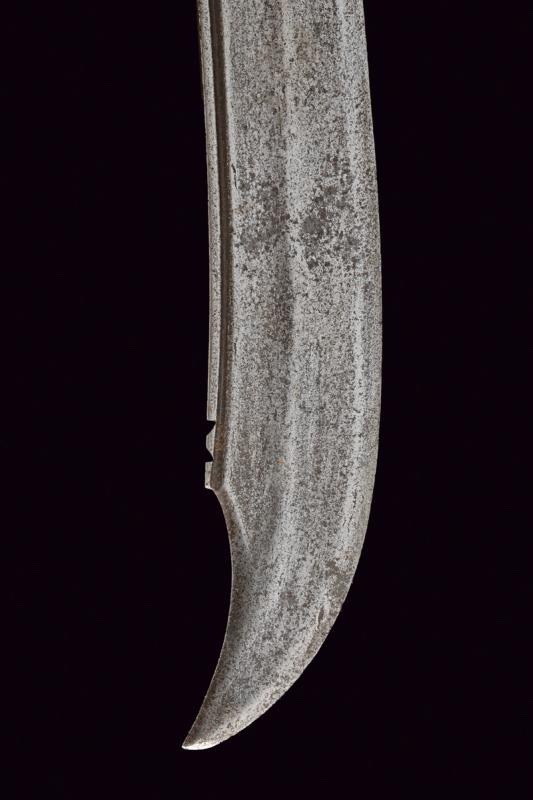
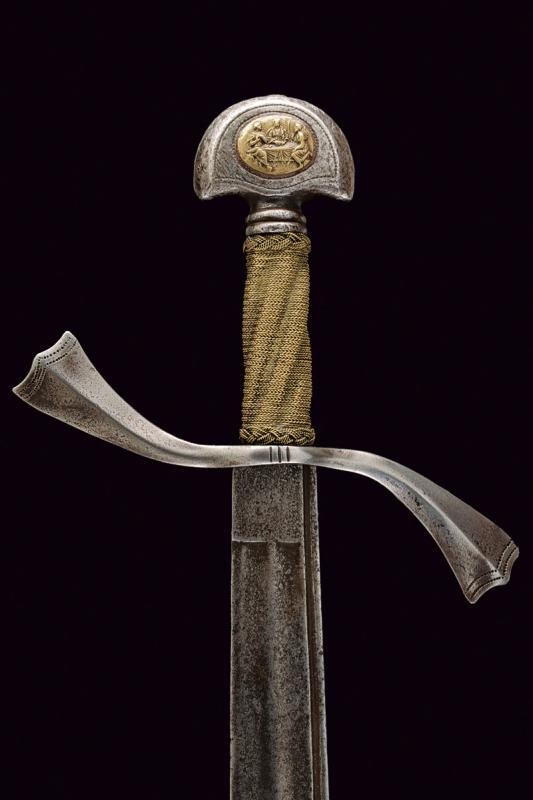
FALCION
Wide, curved, single-and short false-edged blade, hollow tip, double central fuller and dorsal groove, at the end of the back towards the weak two teeth, rectangular tang; iron hilt with "S" quillon, quillons enlarged towards the ends. Wide, iron pommel, on one side in the center a bronze flower, on the other side an oval medallion with a biblical scene in bas-relief. Grip with copper wire binding and moor's heads of the following era.
Italy, Late 16th Century
length 79.5 cm.
283 notes
·
View notes
Photo

Scout series. Which one is your favorite? (1-5, Left to right).
redrootblades.com
.
.
.
#knife #knives #handmade #carbonsteel #survivalknives #bushcraft #hunting #huntingknife #knifepics #tactical #knifelover #fixedblade #edc #americanmade #usamade
#knifepics #kitchenknives #knifemaker (at Portland, Oregon)
https://www.instagram.com/p/CLFWWGhjOb9/?igshid=17t70zhum9otn
18 notes
·
View notes
Photo

Wonderfully preserved rondel dagger, circa 1450. A blade of triangular section inlaid with a gilt mark. Overall length: 60.8 cm (23.94"); Blade length: 48.3 cm (19"). Located at Reichsstadtmuseum Rothenburg, Germany
334 notes
·
View notes
Photo
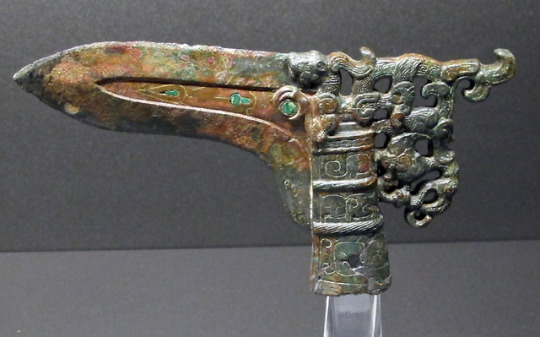
Chinese bronze dagger axe, Spring and Autumn Period, 771 - 476 BC
500 notes
·
View notes
Photo
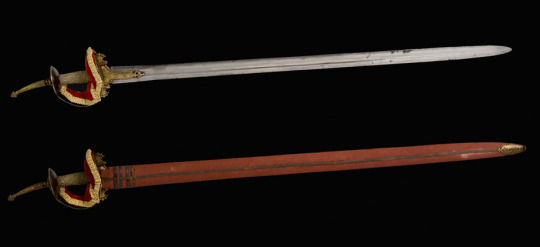


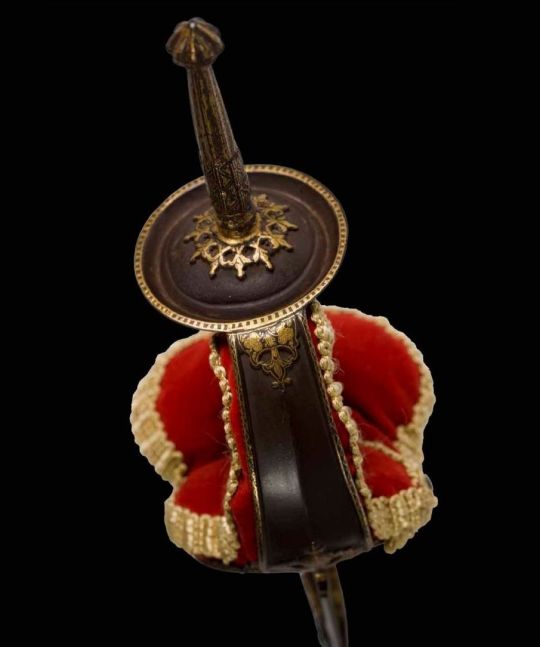
Firangi Sword
Dated: 18th century
Culture: Indian
Medium: steel, gold, wood, velvet
Measurements: overall length 107cm; blade length 84 cm
The Firangi is an Indian weapon used by the Maratha tribes who made them with the blades of the swords that the Portuguese imported from Europe – hence the name firangi meaning foreigner – or were produced locally but imitating their characteristics. This kind of sword always presents a double edged blade, straight and quite long, usually with three or four reinforcement fullers in order to be able to be used with both hands. Usually the hilt would follow a traditional Indian model with a large cup in the shape of a basket and a hand guard connected to the circular pommel and ending in a long spike.
This particular piece shows that traditional European-made blade and a tempered steel hilt with an engraved and gold incrusted floral decoration near the pommel and base of the spike, the grip is covered in fabric. Its scabbard is made of wood, covered in red velvet with a tip in watered steel and “ensuite” decoration. A similar example can be seen in the Hermann Historica, Selected Collector’s pieces (Auction’s Catalogue), Munich, 19 October 2005, lot. 114; Cameron Stone, 1999, p. 229, fig. 283; Tirri, 2004, p. 315, figs. 235-236.
Source: Copyright © 2016 Caravana Collection
1K notes
·
View notes
Photo
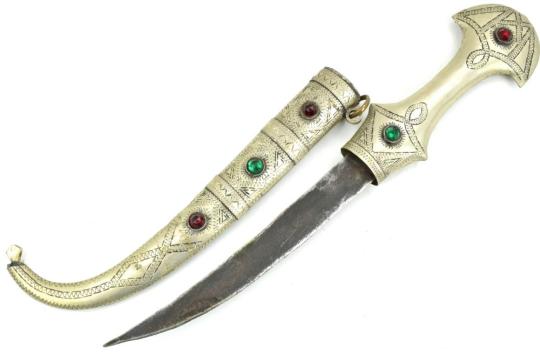
Moroccan koumiya mounted with silver and glass gems, 19th century
from Sofe Design Auctions
130 notes
·
View notes
Text

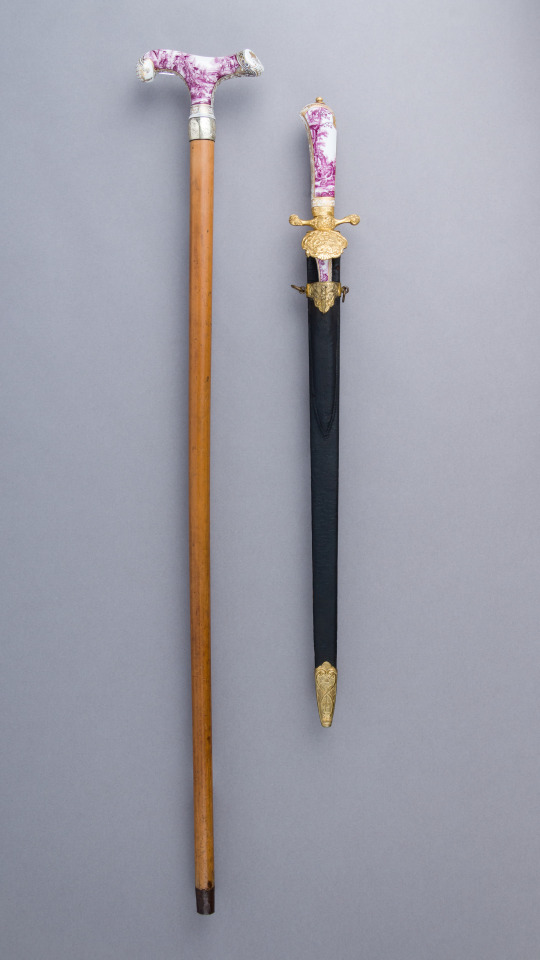
A walking stick, Hunting Sword, and eating knife with matching porcelain hilts,
Sword Length: 23.75 in/60.3 cm
Width: 2.75 in/7 cm
Weight: 13.5 oz/382.7 g
German or Austrian, ca. 1780, housed at the Metropolitan Museum of Art.
925 notes
·
View notes
Photo
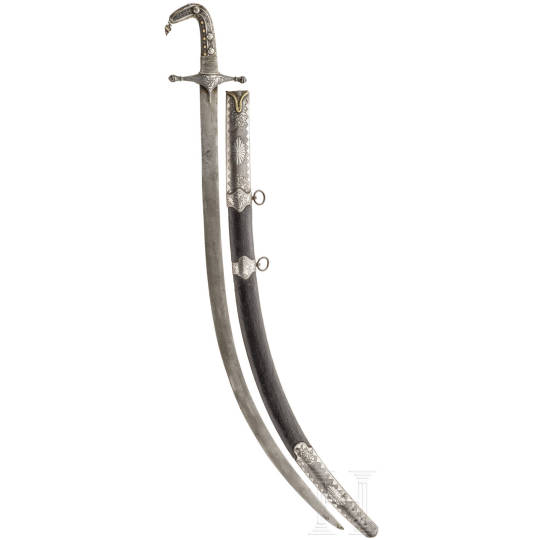

Silver mounted shamshir, Syria, 19th century
from Hermann Historica
208 notes
·
View notes
Link
2 notes
·
View notes
Link
2 notes
·
View notes
